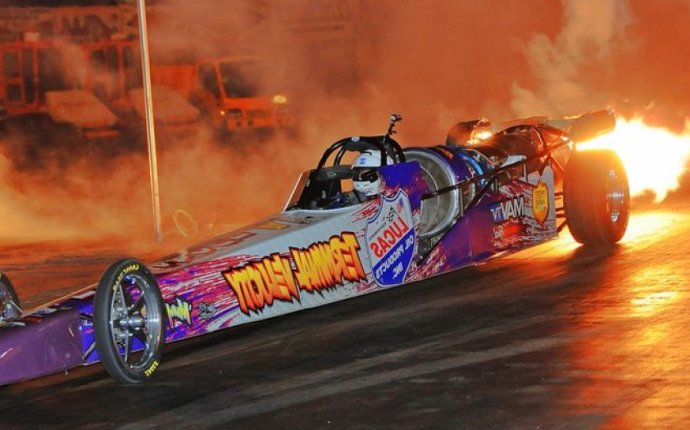
Jet Cars Drag Racing
The first jet dragsters were built by the Arfons brothers, Art and Walt. After their famous falling out at the end of 1960, both brothers separately campaigned jet racers on tracks and pursued the land speed record on the Bonneville Salt Flats. By the summer of 1961, Walt Arfons's jet-powered Green Monster was routinely pacing in the mid-seven-second range. By comparison, Don Garlits barely managed a 7.99 that August with a conventional wheel-driven dragster.
It was all a little too exciting for the NHRA. The early jet dragsters were powered by huge military-surplus engines. The NHRA, fearful of a Challenger-style technical glitch, banned jet cars in November 1961 on the grounds that they were just too dangerous.
The result was that all through the '60s - a period that saw jet cars break the 7.0-second barrier and Art Arfons and Craig Breedlove duel on the salt at 600 mph - the jets were outlaws, racing on unsanctioned tracks or tracks under the auspices of the IHRA or AHRA.
Without the rigor of NHRA safety certification, jet cars continued to toast competitors in spectacular ways. The most notorious jet-car accident came in October 1971 near Dallas when Art Arfons - giving a local newscaster a ride in the Super Cyclops - lost control at 285 mph, killing his passenger and two track workers. Art retired from driving jet cars after the incident.
Despite the amount of bad press jet cars had received - and you know the press is going to be bad when you kill the journalist - jet cars were eventually accepted back into the bosom of the NHRA, thanks to Roger Gustin.
Gustin was an established name in Funny Car racing in the late '60s and well respected in the NHRA. When he decided in the early '70s to switch to a Romeo Palamides-built jet Funny Car, he had the clout to get the NHRA to revisit the issue of jet cars. The NHRA agreed to sanction the cars and wrote the safety regs to govern them. In November 1974, Gustin became the first driver licensed by the NHRA to campaign a jet dragster.
Twenty-five years later, there are about 35 jet cars in circulation and perhaps 50 licensed drivers. But NHRA sanctioning has come with strings attached, says Dennis Roslansky, president of ProJet, a drivers' association that deals with the NHRA. Jet-powered cars are considered exhibition vehicles only. No race category. No prize money.
And most onerous of all for the drivers, the NHRA imposes a speed limit currently 320.99 mph (the number has crept up from 260 mph when Gustin was first licensed).
"The NHRA wants to protect the drawing power of the Top Fuel cars and keep jet cars from overshadowing them, " says Roslansky. "And you can't blame them. That is where the money is."
Meanwhile, the ProJet membership is divided over whether open competition would be a good thing. On the one hand, keeping jet cars exhibition-only lowers their costs; an earth-shaking, fire-spitting, 300-mph jet dragster runs anywhere from $80, 000 to $100, 000 - approximately what a Top Fuel team spends on Cheez Doodles.
And, typically, whatever jetjocks need in the way of parts, they fabricate. "We live the way drag racing used to, " says Roslansky. "We can't go out and buy the parts we need. We have to make them from scratch, using a hammer and a grinder and a welder."
All that would change if jets went racing for real. If championship points, prize money, and sponsorships were at stake, racing costs could go through the roof, as they have with Top Fuel and even the once grass-roots Alcohol divisions. Fun-seeking amateurs would be driven from the sport.
It's in the NHRA's interest to keep the jet cars amateur, according to industry insiders. Currently, smaller tracks that can't afford the appearance fees of the Top Fuel cars can bring in jet cars - which put on a fire and smoke show worthy of the wrathful Yahweh - for $2500 per day per car. In fact, this year track owners are lobbying ProJet for a reduction in appearance fees to a mere $2000 a day.
As long as jet cars remain exhibitions, jetjocks can't make any money on them. "I'm living in poverty, " says Roslansky, one of the few full-time jetjocks. "I live in a trailer in the middle of Kentucky, for crying out loud."









